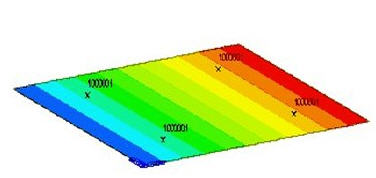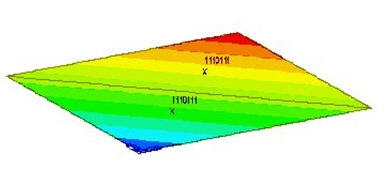Plane-Stress/Plate Stresses
Check the stress distribution of plane-stress elements or plate elements in Contours.
From the Main Menu select Results > Stresses > Plane-Stress/Plate Stresses.
Select Results > Stresses > Plane-Stress/Plate Stresses in the Menu tab of the Tree Menu.
Click ![]() Plane-Stress/Plate Stresses
in the Icon
Menu.
Plane-Stress/Plate Stresses
in the Icon
Menu.
 Load Cases/Combinations
Load Cases/Combinations
Select a desired load case, load combination or envelope case.
Click ![]() to the right to enter new or modify existing load combinations.
(Refer to "Load
Cases / Combinations")
to the right to enter new or modify existing load combinations.
(Refer to "Load
Cases / Combinations")
Step
Specify the step for which the analysis results are to be produced.
The Step is defined in geometric nonlinear analysis as Load Step,
and additional steps are defined in the construction stages of
highrise buildings or heat of hydration analyses.
Note 1
The Construction Stage applicable for the output of the construction
stage analysis is defined in Select
Construction Stage for Display or Stage Toolbar.
Note 2
When pushover analysis is performed for a structure containing Plate, Plane Stress or Solid elements, the pushover analysis results for Plate, Plane Stress or Solid elements can be produced by Steps.
|
|
 Components
Components
Select the desired stress component among the following:
For UCS
Sig-XX: Axial stress in GCS X-direction
Sig-YY: Axial stress in GCS Y-direction
Sig-ZZ: Axial stress in GCS Z-direction
Sig-XY: Shear stress in GCS X-Y plane
Sig-YZ: Shear stress in GCS Y-Z plane
Sig-XZ: Shear stress in GCS X-Z plane
Sig-Max: Maximum Principal Stress
Sig-Min: Minimum Principal Stress
Sig-EFF: Effective stress (von-Mises Stress)
Max-Shear: Maximum shear stress (Tresca Stress)
For Local
Sig - xx: Axial stress in the element's local x-direction (Perpendicular to local y-z plane)
Sig - yy: Axial stress in the element's local y-direction (Perpendicular to local x-z plane)
Sig - xy: Shear stress in the element's local x - y plane (In-plane shear stress)
Vector: Display the maximum and minimum principal stresses in vectors
Vector Scale Factor: Drawing scale for the vector diagram
 Type of Display
Type of Display
Define the type of display as follows :
Contour |
Display the stresses of plane-stress/plate elements in contour. |
|
Ranges: Define the contour ranges.
Note
Number
of Colors: Assign the number of colors to be included
in the contour (select among 6, 12, 18, 24 colors) Colors: Assign or control the colors of the contour.
Color Table: Assign the type of Colors.
Reverse Contour: Check on to reverse the sequence of color variation in the contour.
Contour Line: Assign the boundary line color of the contour
Element
Edge: Assign the color of element edges while displaying
the contour
Contour Options: Specify options for contour representation
Contour Fill
Gradient
Fill: Display color gradient (shading) in the contour.
Draw
Contour Line Only
Mono line: Display the boundaries of the contour in a mono color.
Contour
Annotation
Spacing: Specify the spacing of the legend or annotation.
Coarse
Contour (faster) (for large plate or solid model)
Extrude The option is not concurrently applicable with the Deformed Shape option. Similarly, the option cannot be concurrently applied to the cases where the Hidden option is used to display plate element thicknesses or the Both option is used to represent Top & Bottom member forces (stresses). |
Deform |
Display the deformed shape of the model. |
|
Deformation
Scale Factor Deformation
Type
Nodal
Deform: Display the deformed shape only with nodal
displacements. Real
Displacement (Auto-Scale off): The true deformation
of the structure is graphically represented without magnifying
or reducing it. This option is typically used for geometric
nonlinear analysis reflecting large displacement. Relative Displacement: The deformation of the structure is graphically represented relative to the minimum nodal displacement, which is set to "0" |
Values |
Display the stresses of plain-stress/plate elements in numerical values. The font and color of the
numbers can be controlled in |
|
Decimal
Points: Assign decimal points for the displayed
numbers Min
& Max: Display the maximum and minimum values Set Orientation: Display orientation of numerical values
Note |
Legend |
Display various references related to analysis results to the right or left of the working window. |
|
Legend Position: Position of the legend in the display window
Rank Value Type: Specify a type of values in the Legend and the number of decimal points. |
Animate |
Dynamically simulate the stresses of the plain-stress/plate elements. Click |
|
Animation Mode: Determine the type of animation for analysis results.
Animate
Contour: Option to change the color of the contour
representing the transition according to the magnitudes
of variation
Note AVI Options: Enter the options required to produce the animation window.
Bits
per Pixel: Number of bits per pixel to create the
default window for animation Construction Stage Option: Select the animation options when the construction stage analysis is performed.
Stage
Animation: Animations by construction stages |
Undeformed |
Overlap the undeformed and deformed shapes of the model. |
Mirrored |
"Mirrored" allows the user to expand the analysis results obtained from a half or quarter model into the results for the full model by reflecting planes. |
|
Half
Model Mirroring |
Yield Point |
If the analysis results produced by material nonlinear analysis exceed the yield stress of Plastic Material defined in Initial Uniaxial Yield Stress, Hinge is produced at Gauss Point. |
Note 1
Yield Point is applicable in Plane Stress Elements and Plate Elements.
Note 2
For displaying Yield Points on a Plate Element, a Laminated Shell model with 7 layers has been used in order to consider material nonlinear analysis. To check the yield state of Gauss Points, "0.1" is applied from bottom to top. "0" represents the state of elasticity and "1" the state of yielding. For rectangular or triangular elements, the method of displaying "0.1" is identical.

|
|
Rectangular Element |
Triangular Element |
Cutting Diagram |
Graphically display the stresses of the plain-stress/plate elements along the cutting line or plane. |
|
Click |
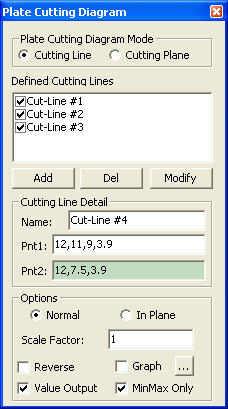
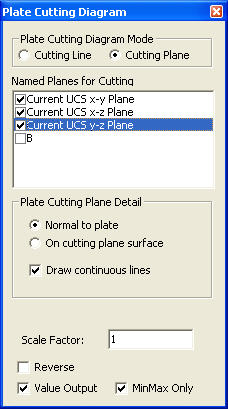
Plate Cutting Diagram dialog box
 Plate Cutting Diagram
Mode
Plate Cutting Diagram
Mode
Cutting Line: Produce a graph along a cutting line
Cutting Plane: Produce a graph along the line of intersection of the cutting plane and plate elements
![]() When
Cutting Plane is selected
When
Cutting Plane is selected
 Value Option
Value Option
Select an option to display the absolute maximum value or the center value when producing analysis results.
Max: Display the absolute maximum value among the plate element analysis results.
Element Center: Display the center value among the plate element analysis results.
 Batch Output Generation (
Batch Output Generation (  ,
,  )
)
Given the types of analysis results for Graphic outputs, generate consecutively graphic outputs for selected load cases and combinations. A total number of files equal to the products of the numbers of checked items in the three columns of the dialog box below are created.
|
Assign a Base File Name under which the types of results (selection data in the Batch Output Generation dialog box for graphic outputs) are stored. |
|
Specify the Base Files to perform Batch Output Generation, construction stages, load cases (combinations), steps, etc. in the following dialog box. |
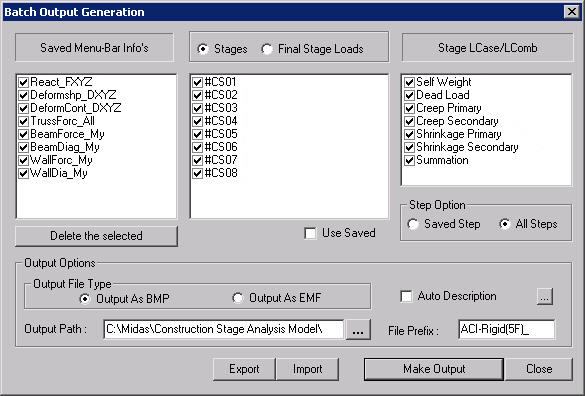
Batch Output Generation dialog box
Saved Menu-Bar Info's: Listed here are the Base Files. Select the Base File Names for Batch Output.
![]() : Delete all the
Base Files selected with the mouse.
: Delete all the
Base Files selected with the mouse.
When the construction stage analysis is carried out, all the construction stages are listed. We simply select the stages of interests to be included in the batch output. If no construction stage analysis is performed, the column in the dialog box becomes inactive and lists load (combination) conditions.
Stages
The results output of all the construction stages are produced.
The construction stages are listed below.
Final
Stage Loads
The results output for only the Final Stage are produced. The construction
stages are listed below. If no construction stage analysis is
performed, the load (combination) conditions are listed.
Use
Saved
Apply only the (saved) step or load (combination) condition selected
at the time of creating each Base File.
Stage
LCase/LComb
When the construction stage analysis is carried out, the auto-generated
construction stage load conditions and the additionally entered
construction stage load combinations are listed. Check on only
the load (combination) conditions that will be used to produce
batch outputs. This column becomes inactive if 'Final Stage Loads'is
selected or no construction stage analysis is carried out.
Step
Option
Specify the steps for which the outputs will be produced when the
construction stage analysis or large displacement geometric nonlinear
analysis is performed.
Saved Step: Use only the steps used for creating the Base Files
All Steps: Use all the steps
Output Options
Output
File Type
Select a Graphic File type, either BMP or EMF.
Auto
Description: At the top left of the Graphic Outputs produced
in batch, auto-generate and include the notes such as the types
and components of the analysis results, construction stages and
steps, load (combination) conditions, etc. The font size, color,
type, etc. can be changed upon clicking the button ![]() .
.
Output
Path
Specify the path for saving the graphic files to be produced in
batch.
File Prefix: Specify the prefix of the Graphic Files to be created. The filenames will be consisted of "Prefix"_"Base File Name"_"Load Comb.".bmp(emf) or "Prefix"_"Base File Name"_"Stage"_"Stage LCase"_"Step".bmp(emf).
![]() :
Produce the specified batch Graphic Files reflecting the contents
of the dialog box.
:
Produce the specified batch Graphic Files reflecting the contents
of the dialog box.
![]() /
/ ![]()
Produce the contents of data input
in the Base Files and Batch Output Generation dialog box in a
binary type file (fn.bog). Click the ![]() button
and select a fn.bog to use the same output format.
button
and select a fn.bog to use the same output format.
Note
Import /Export is only meaningful for different projects. In a
given structural model, the Base Files are automatically stored
and listed.

